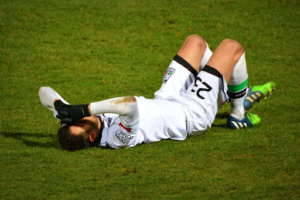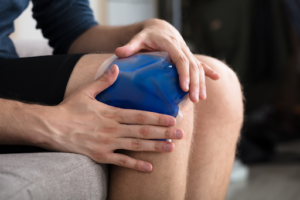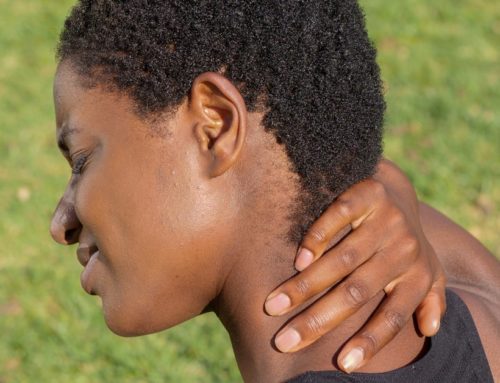We all know that being active is good for our health, but sometimes sports or exercise can put a strain on our bodies. Most sports injuries are of a mild to moderate severity and can be easily treated and sometimes prevented. This article will outline the most common sports injuries and how you can treat them and get back on the field faster.
Common Sports Injuries
Strains and Sprains
A sprain is an injury to a ligament. Ligaments are tough bands that connect bones to a joint. Strains are injuries to tendons or muscle fibers; these anchor muscles to bones. Strains and sprains are the most common sports injuries and can be very painful, but they are usually not severe enough to need surgery. The exception to this is an ACL tear. The ACL is the ligament that holds your leg bone to your knee. Sudden stops or getting hit from the side can cause ACL tears. If the ligament completely tears, you may hear a popping sound. If you suspect an ACL tear, you should always see a doctor right away. Complete tears will require surgery. Other common strains and sprains include hamstring strains, ankle sprain, groin pull, and tennis elbow. These can usually be treated at home.
Shin Splints
Shin splints are common in runners and other athletes. The throbbing pain in the front of your leg is caused by strain on the shin bone that causes inflammation to the connective tissues. Rarely, tiny fractures to the shin can cause similar symptoms.
Shin splints can sometimes be caused by flat feet or ill-fitting shoes. If you are suffering from shin splints, you should consider getting your feet mapped so that you can get orthotic inserts for your shoes. In these cases, proper foot support can keep the shin splint from reoccurring.
Patellofemoral Syndrome
This is an injury that can cause pain in the front of your knee. It is caused by repetitive movement of your kneecap against your thigh bone. This irritates the tissue under the kneecap, resulting in pain. This type of injury commonly affects runners, basketball players, and volleyball players.
Prevention
All of the above injuries can often be prevented by properly warming up before engaging in strenuous activity. The purpose of a warm-up is to gradually bring up your body’s temperature and get your blood flowing. Warmed up muscles and ligaments are less likely to tear.
Warm-up by doing a slower, lighter version of the movements you will be doing during your work out or game. This might include a slow jog or some light weight lifting. Work at this slower, lighter pace for two to three minutes before you amp things up. If you feel tightness or pain anywhere, do some stretching, and be sure not to overwork an area that is feeling sensitive.
Overworking your body is another common cause of sports injuries. You should never work out or play sports to the point of exhaustion. If you call it a day before you are exhausted, you can always play again next weekend. An injury, on the other hand, could keep you out of the game for weeks or even months.
Always make sure that you understand the correct way to perform exercises. Incorrect posture can cause muscle strain and injuries. If you don’t understand an exercise or it causes you pain, stop immediately, and seek guidance from a professional trainer.
Treatment
Most sports injuries can be treated at home using the PRICE method.
P-Protect from additional injury
R-Restrict activity
I- Ice
C- Compression
E- Elevate the injured area
Some injuries, like ankle sprains, may require special exercises to help prevent stiffness and preserve range of motion. Unless your doctor recommends such exercises, it is usually best to rest the injured area.
Ice should be used 20 minutes at a time every one to two hours for the first 48 hours after the injury occurs. Icing the injury will reduce inflammation and relieve pain. Heat should not be applied during this time, as it will encourage swelling and inflammation.
An elastic bandage can be wrapped around the injured area to provide some support and decrease swelling. Make sure that you can still fit a finger under the bandage so that it is not too tight. Elevating the injured area above your heart can help reduce pain, especially if the injury is throbbing. Over the counter pain medications like ibuprofen can also be used to treat pain.
If the pain or swelling is severe or if you notice discoloration of the skin (other than slight bruising), you should see a doctor. You should also get medical attention right away if you cannot put any weight on the injured area or if it looks out of place or doesn’t move correctly.
Patience is key. You may have to stay off the field or out of the gym for several weeks. Some injuries like hamstring strains may take anywhere from 6 months to a year to heal completely. It is important to wait until you are completely healed before you engage in an activity that works the injured area. If you have a joint injury, you may be able to perform low impact exercises like swimming or cycling safely while you wait to return to your normal activities.
Speeding the Healing Process
If you’ve had a sports injury, you are probably eager to get healed up and back to being active. You might also be concerned about the injury’s long term impact on your range of movement or flexibility. Scar tissue can sometimes limit these even after an injury has completely healed. Laser therapy and acoustic compression therapy can be used to speed healing and minimize scar tissue.
Laser therapy is an FDA approved non-invasive treatment that can help sports injuries heal more quickly. It does this by increasing circulation, drawing water, oxygen, and nutrients to the damaged area. This decreases inflammation and helps to relieve muscle spasm, stiffness, and pain. Laser therapy can be used right away after the injury occurs. Regular treatment can shorten healing time.
Acoustic compression therapy is also FDA approved and non-invasive. It uses focused sound waves to increase circulation and break up scar tissue. If you have an injury that has healed but still find that your flexibility is impaired, scar tissue may be to blame. Acoustic compression can decrease scar tissue and help to restore normal movement, reducing stiffness and discomfort.
The PRICE method, combined with laser or acoustic therapy, can lead to the best possible outcome after a sports injury and get you back to being active faster.









